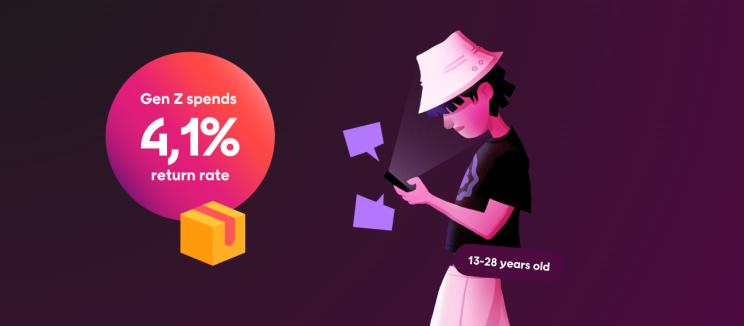As the retail landscape grows more competitive, discounts remain a go-to strategy for driving customer acquisition and boosting sales. But here’s the catch: bigger discounts don’t always mean better results.
When we investigated shopper behavior and discount trends in the Nordics, Germany, Benelux, and the UK, we discovered what’s really happening when retailers turn up the markdown dial.
Let’s paint you a picture and discuss what strategies will serve you the best in 2025.
Discounting trends in the Nordics
Retailers across the Nordics increased their discounting efforts, compared to 2023, both online and in-store. However, higher discounts didn’t result in higher sales volumes. On average, shoppers saved 81 SEK through discounts, but the number of items sold at discounts dropped.
Here are the numbers that back that up:
Discounts in the Nordics – taken from the Retail Radar 2025 report
What this tells us: While shoppers may be spending more per transaction (likely opting for higher-ticket items when discounted), the volume of items sold isn’t growing. More discounts don’t necessarily equal more demand; they just make each sale more expensive for the retailer.
How different generations shop with discounts
Different age groups respond to discounts uniquely, shaped by spending habits, lifestyle, and expectations.
Gen Z
Gen Z saves around 100 SEK on discounts. Digitally native and value-conscious, Gen Z shoppers prioritize quality over quantity. They’re highly responsive to discounts but also show a 44.8% higher return rate than average—hinting at higher expectations around fit, product experience, or ease of returns.
Gen Z has 44,8% higher return rate than average.
Millennials
Millennials save around 94 SEK on discounts. Still leading as consistent shoppers, they often buy for households and show slightly below-average spending growth. Their high return rate shows that convenience is important in how people shop and what they expect satisfaction from.
Gen X
Gen X saves around 83 SEK on discounts. Known for thoughtful and practical shopping, Gen X prioritizes value for money. They tend to purchase slightly more per trip and maintain a low return rate, indicating more deliberate and satisfied purchasing.
Baby Boomers
Baby Boomers save around 60 SEK on discounts. Boomers are purchasing fewer items in each transaction and spending less overall, likely reflecting their priorities in retirement. Their extremely low return rate indicates a strong alignment between their purchases and what they choose to keep.
Seniors (80+)
Seniors (80+) save around 43 SEK on discounts. This group shops less often, clearly focusing on essentials only. Their extremely low return rate shows highly selective and intentional purchasing behavior.
Insight: Younger generations are driven by discounts but tend to return more. Older generations spend less but keep more, showing stronger purchase satisfaction and a more deliberate approach to shopping.
Discount-hunting behavior in Europe
Consumers across Europe are heavily influenced by deals; however, their search behavior and motivations can vary by region.
United Kingdom – Deal-driven, loyalty-curious
- 73% search for deals before buying.
- Gen Z (81%) and Boomers (63%) actively engage with promotions.
- 62% of women and 56% of men regularly look for offers.
- 12.5% may abandon purchases without a discount.
- 8.4%—the highest among the regions—won’t buy if loyalty benefits are missing.
UK shoppers still love a discount, but they’re also looking for exclusivity and recognition. Loyalty programs are a key growth lever. For more insights, download Retail Radar UK here.
Germany – Value-conscious & digitally savvy
- 72% regularly search for discount codes or cashback before buying.
- Gen Z (82%) are the most active, while older generations trail off.
- Women (76%) are more deal-driven than men (67%).
- 15% might not buy without a discount code.
- 6% are discouraged by the lack of a loyalty or membership program.
German shoppers expect visible savings and value-added loyalty options. Make promotions easy to find and loyalty benefits clear. For more insights, download Retail Radar Germany here.
Benelux – Deal-oriented with loyalty awareness
- 73% look for discounts pre-purchase.
- Gen Z (81%) lead again, followed by 63% of Boomers.
- 78% of women and 68% of men are active deal seekers.
- 15% won’t purchase without a code.
- 6% want loyalty perks to seal the deal.
Discounts matter, but pairing them with personalized loyalty offers can drive stronger regional engagement. For more insights, download Retail Radar Benelux here.
Smarter discount strategies moving forward
As stated, deeper discounts don’t always lead to more sales. They often simply shift spending toward higher-priced items without increasing transaction volume—while cutting margins.
Instead of relying on broad markdowns, retailers should consider more strategic approaches that balance value with profitability. Here’s where to start:
1. Targeted Discounting
Segment shoppers by value, frequency, and behavior. High-value customers need less of a nudge than deal hunters.
2. Invest in Loyalty
Many shoppers expect perks. Instead of relying on deep discounts, build loyalty programs that reward frequency, engagement, or even referrals.
3. Optimize Return Reduction
Gen Z’s high return rates hurt profitability. Use better sizing tools, clearer product info, and post-purchase engagement to lower returns.
4. Focus on Timing & Relevance
The right product, at the right price, at the right time = higher impact. Contextual discounting beats blanket codes.
5. Measure Impact by Margin, Not Just Volume
A discount strategy should strike a balance between conversion, value, and profitability. Deep cuts aren’t always worth it if they erode your bottom line.
Let’s sum it up
Discounts still drive behavior, but their effectiveness depends on execution. As shoppers become more strategic, retailers must follow suit.
Bigger doesn’t always mean better. Smarter means sustainable.
Use data to personalize, build loyalty, and deliver value—without undermining your margins. For more insights, read the Retail Radar reports.












